The CSS Solved General Science & Ability (GSA) Past Paper 2024 is Solved by Pakistan’s top GSA Coaches, Miss Iqra Ali and Sir Ammar Hashmi. They are the only coaches available in Pakistan who have solved the last 20 years GSA solved papers to help aspirants know how to attempt the paper to score above 80. And they have guided thousands of CSS and PMS aspirants. Both coaches have been known for their teaching methodology and imparting concepts to their students, who scored the highest marks in this subject. At the special request of CSSPrepForum, both coaches have solved the paper.

PART-II
SECTION-I
Question No. 2
(A) What is the Tuberculosis and Hepatitis? Explain briefly.
Question Breakdown
In this question, the examiner has asked you to explain two pathologies: Tuberculosis and Hepatitis. First, keep in mind that two things are equally asked in the exam. So, split your answer into two halves, each part carrying no more than two and a half marks. To answer Tuberculosis, give a basic understanding, the causative agent, epidemiology, and the available treatment with each header giving to-the-point information. The same would go for Hepatitis. You can give a pictorial representation of the data you put in your question where applicable.
Answer
Tuberculosis
- Understanding Tuberculosis
Tuberculosis (TB) is a bacterial respiratory infection primarily affecting the lungs but can also affect the intestine, bones, joints, lymph nodes, skin and other tissues of the body. According to the World Health Organization TB is the second most killer infectious disease after Covid – 19, leaving even HIV and AIDS behind. The infection has been responsible for around 1.3 million deaths worldwide
- Causes of Tuberculosis
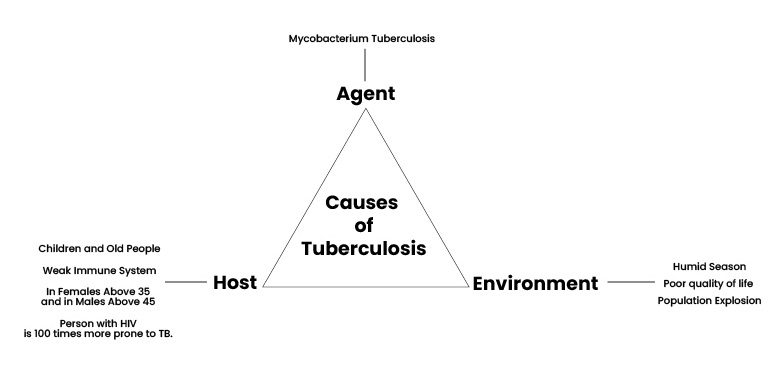
.
- Symptoms of Tuberculosis
Symptoms of Tuberculosis do not show up in the patient having latent Tuberculosis. Only the people having active TB exhibit the symptoms of the infection that include
- Prolonged cough (sometimes with blood)
- Fatigue
- Chest pain
- Weakness
- Night Sweats
- Weight loss
- Fever
- Prevention and Treatment of Tuberculosis
For prevention, the bacilli Calmette-Guérin (BCG) vaccine, which is the live attenuated vaccine form of Mycobacterium bovis, is the only effective vaccine.
Treatment of Tuberculosis can take at least two years, and results are still poor. Second-line drugs that are used for the treatment of Tuberculosis include
- Azithromycin
- Clarithromycin
- Ofloxacin
- Cycloserine, etc
It is necessary for the patient to complete the full course of medication, particularly in the case of multi-drug resistance TB where the patient may need to be hospitalized.
Hepatitis
- Understanding Hepatitis
Hepa: Liver; itis: Inflammation
Hepatitis is the inflammation of the liver mainly caused by any of the half a dozen of viruses and noninfectious agents leading to multiple health problems, some of which can be fatal.
- Causes of Hepatitis
There are five main strains of the hepatitis virus
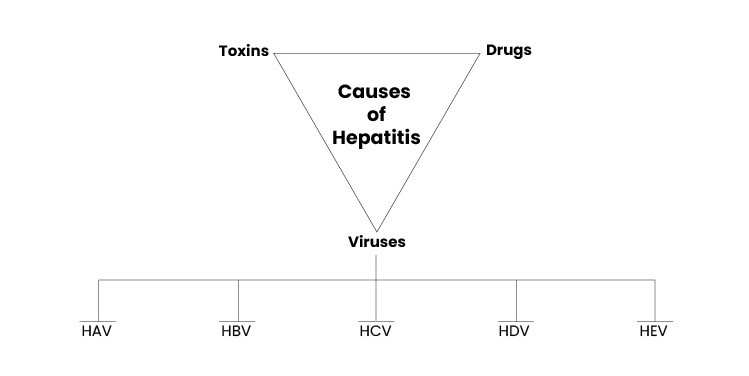
- Symptoms of Hepatitis
Symptoms and their intensity in Hepatitis may vary from one type to another, the general symptoms include
- Jaundice
- Abdominal Pain
- Liver Enlargement
- Fatigue
- Low Grade Fever
- Loss of Appetite
- Prevention and Treatment of Hepatitis
For prevention, vaccines of all type of Hepatitis are available except Hepatitis C. To prevent from HCV virus, patients are advised to avoid used syringes, ensure safe hygiene practices, and implement blood safety strategies.
As far as treatment is concerned, Hepatitis A, B, and E do not require proscribed treatment; they generally resolve on their own. Hepatitis C is mostly treated with antiviral drugs. However, there is no established treatment for Hepatitis D.
The same question has been asked in General Science and Ability Paper 2020, Question No. 5(A) and General Science and Ability Paper 2023, Question No. 3(D). Therefore, do not forget to go through that, too, while preparing for the topic
(B) Explain the mechanism of Fiber Optic Cable for signal. Explain its construction.
Question Breakdown
In the first part of the question, the examiner has asked you to explain optical fibres and their mechanism of action. Thus, initiate your answer with the definition of optical fibres. Then, write a very comprehensive mechanism of working. In the next part, explain the construction of optical fibre. you can reorient your question at your ease. For example, write the definition, then the structure, and then the mechanism of action to make your answer more organized. Keep in mind not to write too much in your GSA paper since the question contains no more than five marks. The more the parts of the question become, the less their weightage. Hence, your question must be concise and complete at the same time.
Answer
- Define Optical Fiber
Since the invention of the Photo Phone by Alexander Graham Bell, transmission of signals via a beam of light became possible. Using this idea, optical fibre originated as a device that is used to transmit carrier waves using light or photon particles. The thin strands of optical fibre make the fibre cables’ transmission capacity far greater than other modes of communication, such as copper wire and metallic wires, with much wider bandwidth capability. As a result, it is used in the form of different cables and is being utilized in numerous fields of life.
- Structure of Optical Fiber
Structurally, optical fiber consists on
- Core: thin glass centre of the fibre where light travels. The Core has a diameter of 10 µm– 200 µm
- Cladding: plastic outer optical material surrounded by Core. The refractive index of the cladding is a less than that of the core which is a must conditions for the working of the Optical Fiber.
- Buffer: A polymer layer surrounded by Cladding.
- Jacket: It coats the whole Optic Fiber.
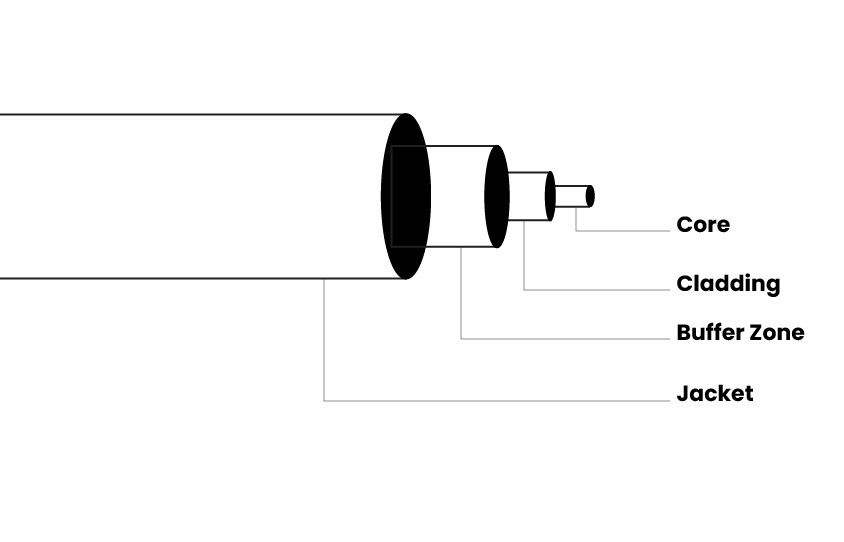
- Mechanism of Action of Optical Fiber
The propagation of light in an optical fibre requires that light should be totally confined within the fibre and not escape from it. This can be done by
- Total internal reflection
- Continuous Refraction
A fibre optic communication system consists of three major components
- A transmitter that converts electrical signals to light signals
- An optical fibre for guiding the signals
- A receiver that captures the light signals at the other end of the fibre and reconverts them to electric signals.
First, an input device, for example, the microphone, converts sound (like a person’s voice) into an electrical signal. The electrical signals are then sent to a transmitter, which includes a light source like a semiconductor laser or LED. The transmitter modulates the light waves digitally. Here, a pulse of light represents the number 1, and the absence of light represents the number 0. This digital light pulse is then sent into the optical fibre. The optical fibre carries the light signals over long distances. Despite being made of ultra-pure glass, light signals gradually become dim over long distances. To maintain the signal strength, devices called repeaters are placed at intervals (typically around 30 km, but up to 100 km in newer systems). These repeaters regenerate the light signals to ensure they remain strong throughout the transmission. At the end of the optical fibre, a photodiode converts the light signals back into electrical signals. These electrical signals are then amplified and decoded, if necessary, to reconstruct the original signals. Finally, the electrical signal is sent to an earpiece, which converts it back into sound.

The same question has been asked in General Science and Ability Paper 2022, Question No. 5(B) and General Science and Ability Paper 2020, Question No. 3(D) Therefore, do not forget to go through that, too, while preparing for the topic
(C) Explain the difference between Middle Latitude Cyclones and Tornadoes.
Question Breakdown
In this question, the examiner has asked the difference between two natural disasters: mid-latitude cyclones and tornadoes. For the questions in which difference is asked, the best approach is to draw a table of difference with two columns, with one entity in the left column and the other in the right, or draw a table with three columns with the first column addressing the characteristics, the second and third columns with the differentiation of the asked entities. So, for this question, you can follow either option with one difference explaining the examples. Also, draw a diagram to make your answer well presented. Remember, in GSA paper, creativity is the key to scoring maximum marks. Lastly, you do not need to draw any diagram in this question.
Answer
| Characteristics | Mid-latitude Cyclones | Tornadoes |
| Define | Middle latitude cyclone is the dominant weather system in middle and high latitudes (at 30 to 60 degree equator), characterized by rapidly swirling air masses around a low-pressure core, which results in stormy and often destructive weather. | A tornado is a small but intense vortex of a spinning column of air associated with the strong updraft of an intense thunderstorm that extends between the earth’s surface and a cloud. It Is also called whirlwind or dust devil. |
| Formation | Middle-latitude cyclones are the result of the dynamic interaction of warm tropical and cold polar air masses at the polar front. | Tornadoes form when warm, humid air collides with cold, dry air. |
| Rotation | Clockwise in the southern hemisphere and counterclockwise in the northern hemisphere. | It also has the same rotation in both hemispheres. |
| Measuring Scale | The scale for measuring cyclones is called the Beaufort Scale and Saffir-Simpson scale. | The scale used for rating the strength of tornadoes is called the Fujita (F) and Enhanced Fujita (EF) Scale. |
| Circumference | They have a wide circumference. | They have a small circumference. |
| Diameter | Diameter 200km | Diameter 300_400 yards |
| Duration | They last for 3 to 10 Days. | They last for less than 10 minutes. |

The same question has been asked in General Science and Ability Paper 2020, Question No. 5 (B) and General Science and Ability Paper 2022, Question No. 2(C). Therefore, do not forget to go through that, too, while preparing for the topic.

(D) What is difference between the ionic and covalent bonding? Give examples.
Question Breakdown
In this question, the examiner has asked you to explain the difference between the two forms of chemical bonding: ionic bonding and covalent bonding. For the questions in which difference is asked, the best approach is to draw a table of difference with two columns, with one entity in the left column and the other in the right, or draw a table with three columns with the first column addressing the characteristics, the second and third columns with the differentiation of the asked entities. So, for this question, you can follow either option with one difference explaining the examples. In the end, draw diagrams depicting the bondings.
Answer
| Characteristics | Ionic Bond | Covalent Bond |
| Definition | The bond that is formed due to the electrostatic attraction between oppositely charged ions is called Ionic bond. | A bond that is formed by the sharing of electron pairs between atoms is called a covalent bond. |
| Electron Interaction | Electrons are transferred from one atom (usually a metal) to another (usually a non-metal). | Electrons are shared, either equally (non-polar) or unequally (polar), between atoms. |
| Bond Formation | Formed when one atom loses electrons (becoming a cation) and another gains electrons (becoming an anion). | Formed when two atoms come together to share electrons. |
| Electronegativity Difference | Electronegativity difference among the elements forming ionic bonds is usually greater than 1.7, hence, are polar | Electronegativity difference among the elements forming ionic bonds is less than 1.7; hence, the bond is non-polar. |
| Bond Strength | Generally stronger in crystalline forms due to the lattice structure of ions, but can be disrupted in aqueous solutions. | Can range from weaker (single bonds) to very strong (triple bonds), depending on the number of shared electron pairs. |
| State at Room Temperature | Generally exists in solid state; many ionic compounds form salts. | It can be solids, liquids, or gases and depends on the molecular structure and size. |
| Solubility | Generally exists in a solid state; many ionic compounds form salts. | Can be soluble or insoluble, depending on polarity. |
| Electrical Conductivity | Compounds with ionic bonding are good conductors when molten or in aqueous solution due to the free-moving ions. | Compounds with covalent bonding are typically poor conductors in all states; molecules do not have free-moving charged particles. |
| Examples | Sodium chloride (NaCl), Magnesium oxide (MgO) (etc.) | Water (H2O), Methane (CH4), Carbon dioxide (CO2). |
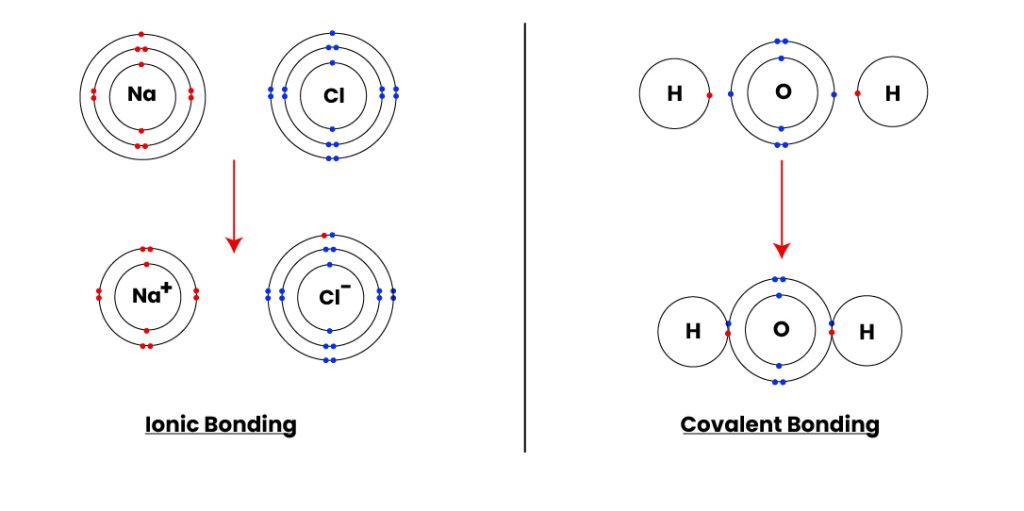
Question no. 3
(A) What is difference between Plastics and Elastics? Explain briefly.
Question Breakdown
In this question of GSA, the examiner has simply asked you to explain the Difference between Plastics and Elastics. For the questions in which difference is asked, the best approach is to draw a table of difference with two columns, with one entity in the left column and the other in the right, or draw a table with three columns with the first column addressing the characteristics, the second and third columns with the differentiation of the asked entities. So, for this question, you can follow either option with one difference, explaining the examples
Answer
| Characteristics | Plastics | Elastics |
| Definition | Plastic are the material that can be re-shaped or re-molded on heating. They can either be synthetic or natural. | Elastics are the material that has ability to return to its normal shape after being compressed or stretched. |
| Response to Force | Deforms (changes shape) permanently under force. | Deforms (changes shape) but returns to its original shape after the removal of force |
| Shape after Deformation | Holds the new, deformed shape. | Retains its original shape after the force is removed. |
| Underlying Property | The ability to permanently deform without breaking. | Ability to return to its original shape after deformation. |
| Applications | Wide range of uses due to their ability to be molded into various shapes: packaging, construction, clothing, medical devices, etc. | Used in applications where a material must stretch and return to its original shape: clothing (waistbands, socks), sports equipment (trampolines, tennis balls), medical uses (bandages, catheters). |
| Chemical Structure | Wide variety of polymers with different structures depending on the type of plastic. | Often have cross-linked polymers, meaning the polymer chains are linked together in a network, allowing them to stretch and recoil. |
| Examples | Water bottles, bags, plastic wrap, furniture | Rubber bands, balloons, bungee cords, spandex |
(B) What is the role of remote sensing and GIS in Environmental Science? Discuss briefly.
Question Breakdown
In this question of GSA paper, the examiner asked you about the role of remote sensing and GIS in environmental science. Since GIS and RS have almost the same utilization and mechanism of action with slight differences, they would be dealt with collectively. Thus, start your answer by defining both, and then move towards their role in environmental Science.
Answer
Remote Sensing
- Defining Remote Sensing
Remote: Something that is far away
Sensing: Getting information
Remote sensing deals with gathering information from great distances and over broad areas, usually through instruments mounted on aircraft or orbiting spacecraft. These instruments, called remote sensors, measure electromagnetic radiation coming from the Earth’s surface and atmosphere as received at the aircraft or spacecraft platform.
- Applications in Environmental Science
In environmental science, remote sensing plays a vital role with the following functions
- Remote sensing is used to monitor changes in land cover and land use over time to track urbanization, habitat destruction, and deforestation.
- It involves analyzing various spectral bands to assess plant health, forest cover, and agricultural productivity.
- Commonly used indices include the NDVI (Normalized Difference Vegetation Index). Satellites gather data on sea surface temperatures, ice cover, and atmospheric gases, which is crucial for climate change research and modelling.
- RS provides real-time data for disaster response and management by tracking hurricanes, floods, wildfires, and earthquakes, thus facilitating timely interventions.
- RS enhances the monitoring of surface water bodies, glaciers, and groundwater levels, contributing to sustainable water resource management.
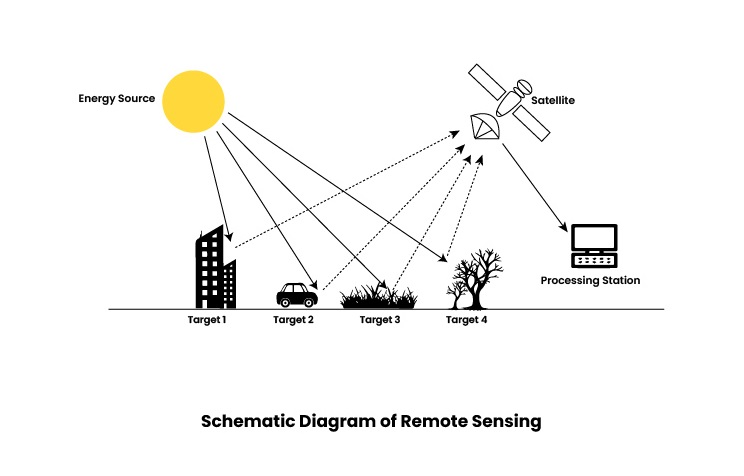
Geographic Information Systems (GIS)
- Defining Geographic Information System (GIS)
A GIS is a powerful computer-based technology that allows a virtually unlimited amount of information to be linked to a geographical location. It is a system of acquiring, processing, storing, manipulating, analyzing, and displaying data which is spatially referred to the earth. In GIS, digital basemap is overlaid with data or other layers of information onto a map to view information.
- Applications in Environmental Science
GIS has a wide range of applications in environmental science. For instance
- It is utilized to create detailed maps showing the distribution of environmental features and phenomena, such as soil types, vegetation, and pollution levels, to provide environmental data analysts with more familiar views of landscapes and associated data.
- It provides a quick, comparative view of hazards (highly prone areas), risks (areas of high risk which may occur), and areas to be safeguarded.
- It supports activities in environmental assessment, monitoring, and mitigation and can also be used to generate environmental models.
- GIS helps identify critical habitats and biodiversity hotspots. It is used to plan conservation strategies and track the effectiveness of conservation efforts
- GIS aids in sustainable urban development by analyzing spatial patterns and predicting future growth, facilitating infrastructure planning, zoning, and green spaces.

The same question has been asked in General Science and Ability Paper 2022, Question No. 5(A). Therefore, do not forget to go through that, too, while preparing for the topic
(C) What are Kepler laws related to the motion of planets?
Question Breakdown
In this question, the examiner demands an explanation of Kepler’s laws related to the motion of planets. So, to answer this question, you are first requested to define Kepler laws, their origin, description, and derivation of Kepler laws. In the end, draw a diagram clearly depicting it. Remember, do not overload the question with excessive information but only the required data. Writing too much will not give you extra marks in anyway. The answer explained here is a little more detailed to get the students grab the concept in entirety.
Answer
In astronomy, Kepler’s laws related to the planets are three scientific laws describing the motion of planets around the sun. The laws were given by Johannes Kepler in the early 1600s. Kepler’s efforts to explain the factors for such motions were insufficient; nonetheless, the actual laws themselves are still considered an accurate description of the motion of any planet and any satellite. These laws are explained as
- Kepler’s first law
Kepler’s first law, also known as the law of ellipses, explains that planets orbit the sun in a path described as an ellipse, not a circle. An ellipse is a special curve in which the sum of the distances from every point on the curve to two other points is a constant. The two other points are known as the foci of the ellipse. The closer together these points are; the more closely the ellipse resembles the shape of a circle. To Kepler, with all planets orbiting the sun in a path that resembles an ellipse, the sun is always located at one of the foci of that ellipse.
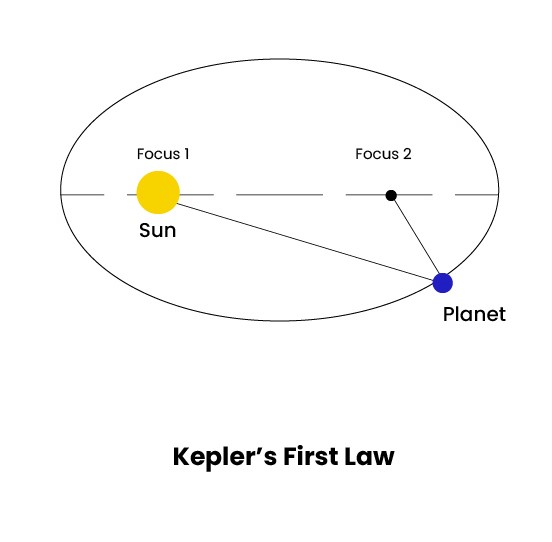
- Kepler’s second law
Kepler’s second law, also known as the law of equal areas, describes how each planet revolves around the sun in such a way that a line joining the planet to the sun sweeps over equal areas in equal intervals of time. For instance, if an imaginary line were drawn from the two planets to the sun, with one planet lying nearest the foci with the sun and the other planet lying the farthest, the area swept out by the line every 31-day month would be the same. It means the areas formed when the earth is closest to the sun can be approximated as a wide but short triangle, whereas the areas formed when the earth is farthest from the sun can be approximated as a narrow but long triangle. Overall, the areas are of the same size. Since the base of these triangles is shortest when the earth is farthest from the sun, the earth would have to be moving more slowly for this imaginary area to be the same size as when the earth is closest to the sun. In other words, the speed at which any planet moves through space constantly changes. A planet moves the fastest when it is closest to the sun, creating a wider base, and the slowest when it is furthest from the sun, creating a narrower base.
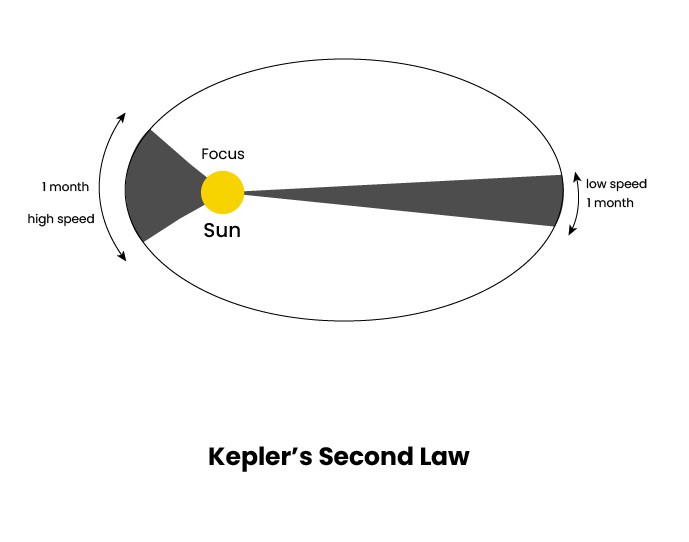
- Kepler’s third law
Kepler’s third law, also known as the law of harmonies, explains that the cube of mean distance of planets from the sun is directly proportional to the square of time it takes to move around the sun.
T2 α R3
Where R = mean distance and T = time
Through the assumption, it provides an accurate description of the period and distance for a planet’s orbits around the sun. Additionally, the same law describes the T2/R3 ratio for any satellite (whether a moon or a man-made satellite) about any planet.
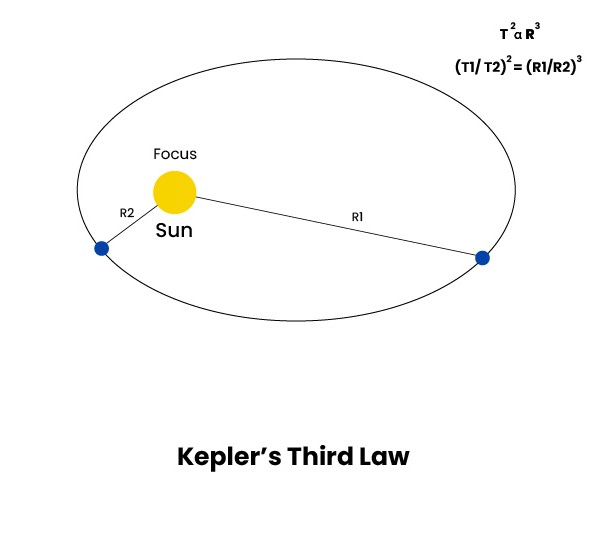
(D) What is difference between preservatives and antioxidants? Discuss briefly with examples.
Question Breakdown
For the questions in which difference is asked, the best approach is to draw a table of difference with two columns with one entity in the left column and the other in the right, or draw a table with three columns with the first column addressing the characteristics, the second and third columns with the differentiation of the asked entities. So, for this question, you can follow either option with one difference, explaining the examples
Answer
| Characteristics | Preservatives | Antioxidants |
| Definition | Preservatives are added to products like food, pharmaceuticals, and cosmetics to prevent spoilage and extend shelf life by inhibiting the growth of harmful microorganisms such as bacteria, yeasts, and molds. | Antioxidants are substances that prevent or slow down the oxidation of other molecules. Oxidation is a chemical reaction that can produce free radicals, leading to chain reactions that may damage cells or spoil products by causing rancidity, loss of flavor, color changes, and nutrient degradation. |
| Purpose | Prevent spoilage by inhibiting microbial growth | Prevent or slow down oxidation reactions |
| Mechanism of Action | Create a hostile environment for microorganisms, lower pH, reduce water activity | Donate electrons to neutralize free radicals, chelate metal ions |
| Examples | Sodium Benzoate, Sorbic Acid, Parabens, Nitrates, Sulfites | Vitamin C, Vitamin E, Butylated Hydroxyanisole (BHA) and Butylated Hydroxytoluene (BHT), Citric Acid, Rosemary Extract |
| Applications | Food, pharmaceuticals, cosmetics, personal care products | Food, oils, cereals, processed products, natural extracts |
Question no. 4
(A) What is role of Carbohydrates and Vitamins in the body? Discuss briefly.
Question Breakdown
In this question, the examiner has asked you to discuss the roles of two major biomolecules of the human body: Carbohydrates and Vitamins. Rationally, the question contains two parts. So, dedicate equal weightage to both parts, assuming two and a half marks for the role of carbohydrates and another two and a half marks for the role of vitamins. Stay to the points after defining both terms. Adding the functions to the tabular form is also acceptable. In the end, do not forget to draw a diagram if required. Remember, writing too much is not a way to obtain maximum marks in the GSA paper, but the student must work on the exact breakdown and presentation of knowledge to score exceptional in the exam.
Answer
Role of Carbohydrates
The word carbohydrate literally means hydrated carbons containing carbon, hydrogen and oxygen. Chemically, carbohydrates are defined as polyhydroxy aldehydes or ketones, which, on hydrolysis, yield polyhydroxy aldehyde or ketone subunits. Examples of Crbohydrates include glucose, fructose, glycogen, and starch. They play both structural and functional roles.
- Structural Role of Carbohydrates
Structural roles of carbohydrates re as follows
- Some carbohydrates are the main constituents of cell walls in plants and microorganisms.
- Proteins and lipids form glycoproteins and glycolipids, respectively, that have a structural role in the extracellular matrix of animals and bacterial cell walls.
- Functional Role of Carbohydrates
Functionally, carbohydrates play the following roles.
- Simple carbohydrates are the main source of energy in cells used to produce ATP (adenosine triphosphate), the energy currency of the cell. Excess energy is stored as another carbohydrate, Glycogen, in the liver that, at the time of need, is hydrolyzed back to its subunit Glucose.
- By providing an easily accessible energy source, carbohydrates spare proteins from being utilized for energy. This allows proteins to be utilized for their primary functions, such as constructing and mending tissues, generating enzymes, and supporting immune function.
Role of Vitamins
Vitamins are organic compounds that are essential for maintaining good health. They are needed in small amounts and must be acquired through the diet because they are not endogenously produced by the body either, or if it produces them, they are not in insufficient quantities.
- Role of Fat-Soluble Vitamins
| Vitamin A | Improves eyesight Maintains the integrity of skin, muscles, and mucous membranes |
| Vitamin D | Helps in the growth of bone tissues Assists in Calcium and Phosphate metabolism |
| Vitamin E | Helps body to produce better defense against diseases Acts as anti-oxidant |
| Vitamin K | Necessary for the synthesis of proteins involved in bone mineralization Plays a key role in blood clotting |
- Role of Water-Soluble Vitamins
| Vitamin B | Acts as cofactors in enzymatic reactions Synthesize red blood cells, fats. and carbohydrates |
| Vitamin C | An anti-oxidant inhibit aging process Heals injuries by producing collagen |
(B) Discuss the functioning of Liver and Pancreas.
Question Breakdown
In this question of the GSA paper, the examiner has asked you functions of two vital organs of the human body: Liver and Pancreas. Rationally, the question contains two parts. So, dedicate equal weightage to both parts, assuming two and a half marks for the function of the pancreas and another two and a half marks for the function of the Liver. Stay to the points after defining both terms. Adding the functions to the tabular form is also acceptable. In the end, do not forget to draw a diagram of both organs in this questions
Answer
Function of Liver
Liver is the largest organ located in the right upper quadrant of THE human body, beneath the diaphragm, and at the top of the right kidney. It performs various functions in the human body include
- Production of bile- a digestive fluid that helps with the digestion and absorption of fats and fat-soluble vitamins.
- Metabolism of proteins, lipids, and carbohydrates through the conversion of lactic acid to glycogen, stored glycogen to glucose, ammonia to urea, and excess carbohydrates and proteins into fatty acids and triglycerides
- Detoxification of many chemicals like ammonia, urea and uric acids from the nitrogen of amino, food additives, pesticides, drugs, etc.
- Synthesis of nitrogenous wastes, Lipids, cholesterol, lipoproteins and plasma proteins like prothrombin, fibrinogen, albumin, etc.
- Storage of Iron and Glycogen
- Recycling of the contents of old red blood cells (e.g., iron and other constituents of haemoglobin)
Function of Pancreas
The pancreas is a leaf shaped glandular organ located in the epigastric region of the abdomen, just behnd the stomach. It performs both endocrine and exocrine functions.
- Endocrine Functions
The regions of pancreas that perform endocrine function is called Islets of Langerhans. They contain its hormone-producing cells
- Alpha Cells are associated with Insulin production, thus maintaining the blood sugar level in the body by suppressing glucose level
- Beta Cells are associated with the secretion of Glucagon, which is antagonistic to insulin, thus maintaining blood sugar levels in the body by increasing glucose level
- Exocrine Functions
Externally, the major role of pancreas is found in the digestive system where
- It produces digestive enzymes
- Amylase to catalyze the digestion of carbohydrate
- Lipase to assist the digestion of fats
- Proteases like trypsin and chymotrypsin for the digestion of proteins
- It secretes bicarbonate into the small intestine to neutralize the acidic chyme (partially digested food) that enters the stomach, thus creating an optimal pH environment for the action of digestive enzymes.

(C) What are the standards of drinking water? How Heavy Metals in the water affect the living organisms?
Question Breakdown
The question consists of two parts. In the first part, the examiner has asked you to explain the standards for quality drinking water, and the second part requires the impacts of heavy metals in water on living organisms. Both parts of the question can be easily and effectively solved in table form. For the first part, draw a table with the parameters in the left column and the maximum acceptable amount in the right column. Likewise, in the second part, draw a table with names of heavy metals in the left column and their impacts on the right column.
Answer
Standards of Drinking Water
- Defining the term “Standards of Drinking Water”
Standards of drinking water are the established guidelines to ensure the quality of water intended for human consumption. The standards are set by various international, like the World Health Organization (WHO) and Europeon Union (EU), and national, like Pakistan Environmental Protection Agency (PakEPA), bodies to protect public health by limiting the presence of contaminants in drinking water.
- Enlisting the Key Parameters For Drinking Water with Their Limit
According to the WHO established guideline to regulate the quality standard of water, there are less and more forty (40) ingredients which have been referred for the good quality of water. Some of them are given below.
| Parameters Category | Parameter Name | Limit |
| Microbiological Parameter | Escherichia coli (E. coli) | 100 mL |
| Enterococci | 100 mL | |
| Chemical Parameter | Arsenic | ≤ 0.02 mg/L |
| Lead | ≤ 0.1 mg/L | |
| Nitrate | ≤ 50 mg/L | |
| Fluoride | ≤ 1.5 mg/L | |
| Physical Parameter | pH | Typically between 6.5 and 8.5 |
| Turbidity | ≤ 1 NTU (Nephelometric Turbidity Units) |
Heavy Metals in Water and Their Effects on Living Organisms
Heavy metals like lead, mercury, cadmium, arsenic, and chromium when added in water not only disturbs the water quality but also impacts living organisms
| Parameter | Effects on Living Organisms |
| Lead | Causes neurological damage in humans, particularly in children, leading to cognitive, intelligence, and behavioral issues. It, further, causes hypertension, renal failure, and reproductive issues. Toxic to aquatic life, causing reproductive issues, and developmental problems in fish and other wildlife. |
| Mercury (Hg) | Causes severe developmental damage, particularly in fetuses and young children, Skin burns, and renal damage; responsible for Minamata disease Affects fish and predators, including humans who consume contaminated fish; reduces reproduction, growth inhibition, and mortality in aquatic organisms. |
| Cadmium (Cd) | Causes kidney damage, skeletal damage, and respiratory problems; classified as a human carcinogen linked to lung and prostate cancer; responsible for Itai-Itai disease Causes growth inhibition, reproductive failure, and mortality in fish and invertebrates |
| Arsenic (As) | Chronic exposure to arsenic can cause skin lesions, diabetes, cardiovascular anomalies, and various cancers; acute exposure leading to severe gastrointestinal symptoms Can be toxic to aquatic plants and animals |
| Chromium (Cr) | Causes skin irritation, respiratory problems, and lung cancer upon inhalation Causes toxicity in aquatic organisms, reducing reproduction, growth inhibition, and mortality |
(D) What is radioactivity Discuss the laws of radioactivity. Name two radio elements.
Question Breakdown
The question rationally consists of three parts: understanding to radioactivity, laws of radioactivity, and the name of two radio elements. So, your answer must not carry more than the content of two marks each. Giving the required weightage to all the asked parts is the only way to get maximum marks in the exam than focusing more on a single part. You, however, can draw a diagram to make your answer more presentable.
Answer
Understanding Radioactivity
- Define Radioactivity
Radioactivity is the phenomenon in which unstable nuclei of certain elements emit electromagnetic radiations: alpha, beta or gamma rays, in its process to attain a stable condition, measured in Curie or Rutherford- the units of radioactivity
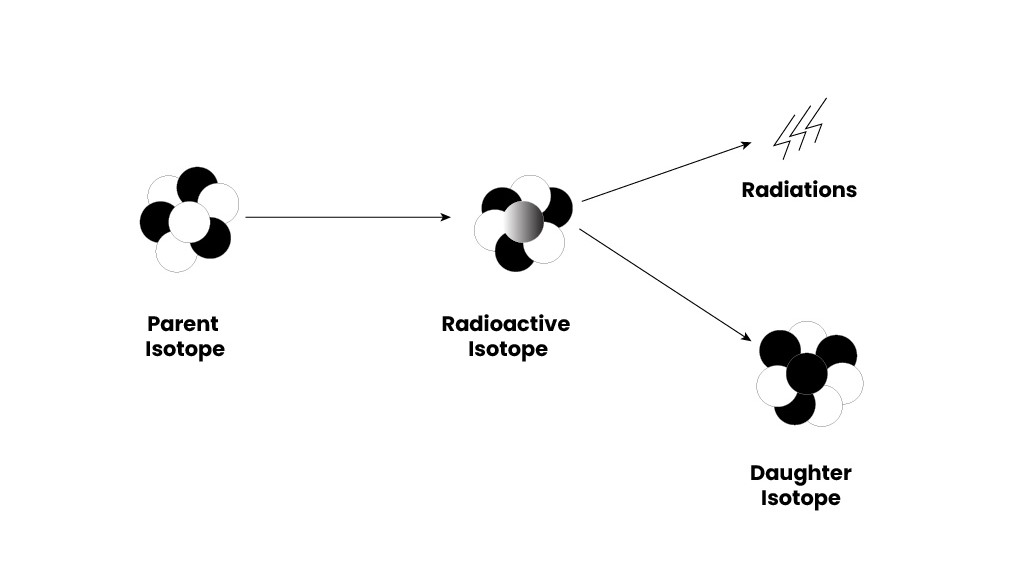
- Discovery of Radioactivity
Radioactivity was first discovered by Henri Becquerel in 1896 in the form of Uranium.
- Types of Radioactivity
Radioactivity can either be
- Natural radioactivity is where the element by default is in unstable condition and keeps emitting radiations till the complete decay OR
- Artificial radioactivity is where the elements are excited to a particular unstable state to get it to act like a radioactive element.
Laws of Radioactivity
- Radioactivity is a spontaneous process happens as a result of the decay of the nuclei.
- The radioactivity rate does not dependent of the extent of the reaction and is not affected by pressure and temperature.
- Radioactivity is based on the conservation laws: conservation of charge, conservation of mass energy, and conservation of momentum
- The chemical and physical properties of the daughter nuclei are independent of the properties of the mother nucleus.
- The energy emitted in radioactivity is always accompanied by the alpha, beta and gamma particles.
- The decay rate of radioactive substances depends on the number of atoms at the time.
Names of Radioactive elements
- Uranium-238 (U-238) emits alpha radiations and forms Thorium-234 (Th-234).
- Radium-226 (Ra-226) also emits alpha radiations and forms Radon-222 (Rn-222).
The same question has been asked in General Science and Ability Paper 2020, Question No. 4 (C). Therefore, do not forget to go through that, too, while preparing for the topic.
Question no. 5
(A) What are the Plant nutrition elements? Enumerate them.
Question Breakdown
In this question, the examiner asked you to explain the nutritional elements of plants. To solve, first you are supposed to define the plant’s nutrition elements in your own words. Then, to enumerate the elements, since different figures are available on global databases, quote any renowned organization or think-tank so that your answer can be backed by proper evidence. Do the same to clear the clash of facts in different resources. You can draw an organogram to represent your question knowledge in pictorial form, thus enhancing your presentation.
Answer
- Understanding Nutrition Elements
The elements that are indispensable as plant constituents for biochemical reactions, and the production of organic materials by photosynthesis proper growth, reproduction, and functioning of plants are called plant nutrition elements in accordance with Justus von Liebig’s law of the minimum. Different elements are critical for different functions at the different part of plants’ lives. Hence, without them, the plant may lead to withering and death.
- Enumeration of Plants’ Nutrition Elements
Per the Plant Nutrition for Food Security Report published by the United Nations Food and Agricultural Organization (FAO), almost ninety natural elements are found in plants, with most of them having no function (e.g. the heavy metal gold). However, sixteen (16) elements are essential for the optimal development of plants.
a. Macronutrients
The nutrients that are required by plants in large amounts for nutrition are called macronutrients. These are nine (9) in number
- Nitrogen (N), being the most abundant element, is required for amino acids, proteins, enzymes, and chlorophyll
- Phosphorus (P) is essential for energy transfer (ATP), nucleic acids, and root development.
- Potassium (K) helps in regulating water uptake and photosynthesis
- Calcium (Ca) is required for cell wall structure, membrane function, and plants’ overall development.
- Magnesium (Mg) is involved in enzyme activation and photosynthesis.
- Sulphur (S) aids in protein synthesis by aminoacids.
- Carbon (C) being obtained from CO2 through photosynthesis is the fundamental component of all organic molecules and the process of photosynthesis itself
- Oxygen (O) is essential for cellular respiration and as a part of water and organic molecules.
- Hydrogen (H) is involved in energy transfer and photosynthesis.
b. Micronutrients
The nutrients that are required in trace amounts for the proper development and functioning of plants are called micronutrients. These are eight in number
- Chlorine (Cl)
- Boron (B)
- Iron (Fe)
- Manganese (Mn)
- Copper (Cu)
- Zinc (Zn)
- Molybdenum (Mo)

(B) What is the difference between software and hardware? Give five examples of each
Question Breakdown
In this question, the examiner has asked you to simply differentiate software and hardware. For the questions in which difference is asked, the best approach is to draw a table of difference with two columns, with one entity in the left column and the other in the right, or draw a table with three columns with the first column addressing the characteristics, the second and third columns with the differentiation of the asked entities. So, for this question, you can follow either option with one difference explaining the examples.
Answer
| Characteristics | Hardware | Software |
| Definition | The physical parts of the computer are called HARWARE | The intangible part of the computer that cannot be touched physically are called SOFTWARE |
| Categories | The intangible part of the computer that cannot be touched physically is called SOFTWARE | Categories of Software include System Software and Application Software |
| Development | Developed using electronic and other materials | Developed using programming languages |
| Failure | Physical damage, electrical failures | Bugs, software corruption, compatibility issues |
| Durability | Physically wear out over time | Does not wear out physically but can be affected by bugs and glitches |
| Functionality | Provides the physical means to perform computing tasks | Provides the instructions and controls for hardware to execute tasks |
| Examples | Monitor, Scanner, CD-ROM, Printer (etc.) | Microsoft Word, Internet Explorer, Microsoft Excel (etc.) |
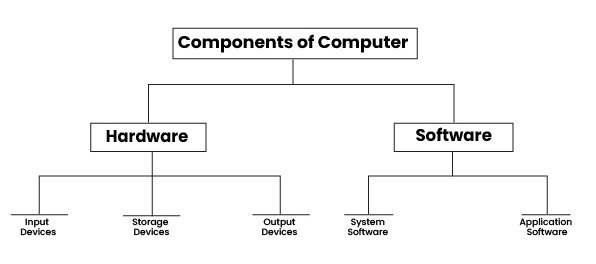
(C) What are the types of earthquake waves? Discuss them
Question Breakdown
In this question, the examiner has asked you to explain the types of earthquakes. To address this question, you are first required to define what exactly the earthquake waves are and how they are formed in no more than a line. Then, move towards the types of Earthquake waves shortly yes comprehensively. In the end, draw an organogram depicting the types in pictorial form. Keep in mind not to write too much in your GSA paper since the question contains no more than five marks. The more the parts of question become, the less get their weightage. Hence, your question must be concise and complete at the same time.
Answer
- Understanding Earthquake Waves
Vibration waves that travel through Earth’s layers due to the movement of tectonic plates in earthquakes, volcanic eruptions, or large man-made explosions giving out low-frequency acoustic energy are called Earthquake waves or Seismic Waves
- Types of Earthquake Waves
There are two main types of seismic waves:
- Body Waves
Body waves, as the name indicates, are the type of earthquake waves that travel through the interior or the body of the Earth and have a frequency higher than the surface wave.
Body wave is divided into two waves
- P waves, also known as primary waves, are longitudinal waves, that is, the particles of the medium move parallel to the propagation of the wave. These are the fastest waves; hence, responsible for dogs being restless before earthquake
- S waves, also known as secondary waves, are transverse waves, that is, the particles of the medium move perpendicular to the propagation of the wave.
- Surface Waves
Surface waves are the earthquake waves that travel near the Earth’s surface, i.e., through the crust. Their frequency is lower than body waves and is highly destructive.
Surface waves are also further divided into two forms
- L waves, also known as Love Waves, are perpendicular sideways waves same like the transverse waves.
- R waves, also known as Rayleigh Waves, are the slowest of all the earthquake waves. They are responsible for to and forth movement of earth just as longitudinal waves, being responsible for the maximum destruction caused by earthquake.

(D) What are longitudinal waves, electromagnetic and Gamma radiations? Discuss them
Question Breakdown
In this question, the examiner has asked you to discuss three kinds of radiations or waves, that is, longitudinal waves, electromagnetic waves, and gamma rays. All you are supposed to do is Define each with example as the description of each carries no more than 1.75 marks. So, instead of filling your paper with extra, unnecessary content, try staying to the point. One thing you can do to score high is to make an organogram clearing the types of waves, highlighting the location of the asked ones.
Answer
Longitudinal Waves
- Definition of Longitudinal Waves
Longitudinal waves are a type of Mechanical Wave in which the particles in the medium move parallel to the direction of propagation of the wave.
- Examples of Longitudinal Waves
Examples of longitudinal waves include
- Sound Wave
- Ultrasound wave
- Seismic P-wave
Electromagnetic Waves
- Definition of Electromagnetic Waves
Electromagnetic waves are the type of waves that do not require a material medium for its propagation. It is created by an electromagnetic field in planes perpendicular to each other.
- Examples of Electromagnetic Waves
Examples of Electromagnetic waves include
- Radio wave
- Microwave
- Infrared wave
- Gamma wave
Gamma Radiations
- Definition of Gamma Radiations
Gamma rays are the type of electromagnetic radiation that is emitted from the radioactive decay of an unstable atomic nuclie. They are similar to X-rays; however, X-rays generally arise from the atomic orbital, while gamma rays are emitted from an excited nucleus.
- Examples of Gamma Radiations
Examples include
- Radiations coming out of lightning
- Nuclear explosions


Question no. 6
(A) If the sum of four numbers is 105. When 03 is added to a number, twice of another number, five times of third number and fourth number becomes equal to each other. What are these numbers in ascending order?
Solution:
- Given data
Let A, B, C, and D are the four numbers.
Thus, according to the given conditions,
A + B + C + D = 105 …………(i)
Also,
A + 3 = 2B = 5C = D
- To find
Four numbers in ascending order
- Solution
To find these four unknowns, place three values equal to the forth, then finding the forth value, that will make the finding of others much easier.
Thus,
| A + 3 = 2B | 5C = 2B | D = 2B ………(iv) |
| A = 2B – 3 ………(ii) | C = 2B/5………(iii) |
Putting these values of A, B, and D in equation (i),

Put the value of B in equation (iv)
Thus,
D = 2(20)
D = 40
Now, put the value of B in equation (ii)
A = 2(20) – 3
A = 40 – 3
A = 37
Now, put the value of B in equation (iii)

- Results
Thus, the numbers in ascending order are 8, 20, 37, 40
(B) Find out the correct word from the given jumbled spellings.
Solution:
| Sr. No | Jumbled Word | Corrected Word |
| 1 | UCTREUTRS | STRUCTURE |
| 2 | LOVONAC | VOLCANO |
| 3 | CIHPROSTATAC | CATASTROPHIC |
| 4 | YNTIAUMH | HUMANITY |
| 5 | NNTHORER | NORTHERN |
(C) Find the missing numbers in the series given below.
Solution:
- i. 121, 11, 81, 9, ? , 7
Every odd place number is the square of the even place number.

- ii. 100, 50, 25, ? , 6.25
Every upcoming number is half of the previous number.

- iii. 4, 9, 64, 125, 1296, ?
The first two numbers are squares of 2 and 3, the next two are cubes of 4 and 5, and the next two are power of four of numbers 6 and 7.

- iv. 2, 5, 12, 24, 48, ?

- v. 44, 22, 66, 33, 132, ?
Every even place term is half of the odd place one.

(D) If the sum of three-digit number is 15 and sum of 10th and unit digit is 12. The difference of unit digit from 10th digit is equal to 02. What is the three-digit number?
Solution:
- Given data
The sum of three digits of a three-digit number = 15
The sum of tens digit and unit digit = 12
The difference of unit digit from tens digit = 2
- Required
Find the three-digit number = ?
- Solution
Let unit, tens, and hundreds numbers be U, T, and H, respectively.
Thus, according to the given statements,
U + T + H = 15 ————- (I)
U + T = 12 —————–(ii)
T – U = 2 ——————-(iii)
Adding equation (ii) and (iii),
2T = 14
T = 7
Put the value of T in equation ii,
U + 7 = 12
U = 5
Put the value of U and T in equation i,
7 + 5 + H = 15
12 + H = 15
H = 3
Thus, the number is 573.
Question No. 7
(A) A man travels over the path of a right-angle triangle having base and hypotenuse 4 and 5 kilometers, respectively. After a complete round he continues in the same direction for 6 km and then turns 90 degree and continues for another 8 km. How long he has travelled and how far he is from his starting point?
Solution:
- Given data
A man travels a right triangle-shaped path with a base of 4 km and hypotenuse of 5 km.
He completes a round and continues for 6 km.
Then, he turns 90 degrees and travels 8 km.
- To find
Total distance travelled =?
How far the man is from the starting point=?
- Solution
First, find out the perpendicular of the right-angle triangle,

Thus, according to the Pythagoras theorem
H2 = P2 + B2
(5)2 = P2 + (4)2
25 = P2 + 16
P2 = 25 – 16
P2 = 9
Taking square root on both sides,
P = 3 km
Now, as per the given data, he travels 6 km in the same direction and 8 km after turning 90 degrees, thus,

For triangle CDE, according to the Pythagoras theorem
H2 = P2 + B2
H2 = (6)2 + (8)2
H2 = 36 + 46
H2 = 100
Taking square root on both sides,
H = 10 km
Thus, total distance travelled = 4 + 3 + 5 + 6 + 8 = 26 km
And, 10 km away from the starting point, i.e., C
(B) Hassan, Ali, Akbar, Nasir, Shehbaz are classmates having different pocket money. Hassan’s pocket money is one third as much as of Ali and Ali has five times as much as Akbar. Akbar has thrice as much as Nasir and Shahbaz gets equal to Nasir and that of Ali. If they get Rs. 8000, then find the pocket money of each.
Solution:
- Given data
There are five boys Hassan, Ali, Akbar, Nasir, and Shahbaz with different pocket money and their sum of pocket money is Rs. 8000
- Required
Pocket money of each =?
- Solution
According to the given condition,
Hassan = 1/3 (Ali)
Ali = 5 (Akbar)
Akbar = 3 (Nasir)
Shahbaz = Nasir + Ali
Now,
Let the pocket money of Nasir = x
Thus,
Akbar = 3x
Ali = 5 (3x) = 15x
Hassan = 1/3 (15x) = 5x
Shahbaz = Nasir + Ali
Shahbaz = x + 15x = 16x
As the sum of their pocket money = 8000
Thus,
Nasir + Akbar + Ali + Hassan + Shahbaz = 8000
X + 3x + 15x + 5x + 15x = 8000
40x = 8000
X = 8000/40
X = 200
Thus, Nasir’s pocket money = Rs. 200
Akbar = 3(200) = Rs. 600
Ali = 15(200) = Rs. 3000
Hassan = 5(200) = Rs. 1000
Shahbaz = 16(200) = Rs. 3200
(C) What will be the surface area and volume of a sphere if it has a radius of 7 m?
Solution:
- Given data
Radius of sphere = 7 m
- Required
Volume of sphere =?
The surface area of the sphere =?
- Solution
Since the volume of the sphere is

(D) Distribute Rs 4320 among Zain, Aslam, and Ashraf in such a way that if Zain gets 2 parts then Aslam gets three parts, whereas Ashraf gets seven parts.
Solution:
- Given data
Total amount to be distributed = Rs 4320
Zain gets parts = 2
Aslam gets parts = 3
Ashraf gets parts = 7
- Required
Share of each =?
- Solution
Total parts = 2 + 3 + 7 = 12
Share of Zain = 2/12 x 4320
Share of Zain = Rs 720
Share of Aslam = 3/12 x 4320
Share of Aslam = Rs 1080
Share of Ashraf = 7/12 x 4320
Share of Ashraf = Rs 2520
Question no. 8
(A) A man purchases a car in an amount of Rs 2400,000 in which he pays one-fourth extra as profit. Find the original amount of car and the amount of profit.
Solution:
- Given data
Purchasing amount of car = Rs 2400,000
Profit in the purchasing amount = 1/4th
- Required
Original amount of car =?
Profit =?
- Solution
Let the original price of the car be x.
The man pays 1/4th extra as profit, which means the total price he pays is:
𝑥+𝑥/4=2400000
5x/4 =2400000
𝑥 = (4/5) x 2400000
Now, solving for x:
𝑥=1920000
So, the original price of the car is Rs. 1,920,000.
Profit:
Profit=2400000−1920000=480000
So, the profit is Rs. 480,000.
(B) Twelve men can complete a job in twenty-four days. After four days, four persons quit. In how many days this job will be completed by the remaining persons.
Solution:
- Given data
Initial no. of men = 12
Initial no. of days = 24
After 4 days, 4 men leave, then,
Final no. of men = M2 = 8
- Required
Final no. of days = D2 =?
- Solution
Since, 4 men that leave after 4 days do the work as per their routine,
There are two ways to solve this question.
- Finding the work done by 4 workers in 4 days and subtracting it from total work and then calculating number of days required to complete the remaining work.
- The equation can be molded as if the men continued their work, it would have taken 20 more days for 12 men. Thus, this will become our initial condition and the present condition is the same, 8 men and required are the number of days.
Thus, using the second method,
M1 = 12
D1 = 20
M2 =8
D2= ?
Since the no. of men and no. of days are inversely proportional because as the no. of men increases, the no. of days decreases, thus,
M x 1/D
M= K/D
K = M x D
So,
M1 x D1 = M2 x D2
D2 = M1 x D1 / M2
D2 = 12 X 20/8
D2 = 30 days
(C) The shadow of a 10 m tall tree is falling on a high rise building and its height is 100 m. If the tree is 20 m away from the wall, at what distance from the wall is the light source?
Solution:
- Given data
Height of the tree (h) = 10 meters
Height of the building (H) = 100 meters
Distance from the tree to the wall (d) = 20 meters

- To find
The distance between the light source and the building wall =?
- Solution
According to the triangular theorem, as two concurrent triangles are formed thus, the ratio of their corresponding sides will be equal.
The triangles are ADE and ABC, thus,

Since total distance = x + 20
Thus, total distance = 2.22 + 20 = 22.2 m
Therefore, the light source is 22.2 meters away from the wall.
(D) There are three cars and start moving in such a way that car A and car B are moving opposite with speed 60 and 100 km/h. Car C is moving perpendicularly to both with speed 80 km/h. what is the distance after 15 minutes between (i) A and B (ii) A and C (iii) B and C ?
Solution:
- Given data
Speed of car A = 60 km/h
Speed of car B = 100 km/h
Speed of car C = 80 km/h
- To find
Distances after 15 minutes =?
- Solution:
According to the given condition

Distance covered in 15 minutes (1/4 hour),
By car A = (60 km/h) (1/4) = 15 km
By car B = (100 km/h) (1/4) = 25 km
By car C = (80 km/h) (1/4) = 20 km
(i).
From the starting point, car A has travelled 15 km while car B has travelled 25 km. thus, the distance between car A and car B = 40 km
(ii).
From the starting point, car A has travelled 15 km while car C has travelled 20 km. thus, the distance between car A and car C can be found by the Pythagoras theorem,
H2 = P2 + B2
H2 = 202 + 152
H2 = 400 + 225
H2 = 625
Taking square root on both sides,
H = 25
Thus, the distance between A and C = 25 km
(iii).
From the starting point, car B has travelled 25 km while car C has travelled 20 km. thus, the distance between car B and car C can be found by the Pythagoras theorem,
H2 = P2 + B2
H2 = 202 + 252
H2 = 400 + 625
H2 = 1025
Taking square root on both sides,
H = 32.01
Thus, the distance between B and C = 32.01 km
CSS Solved Past Papers’ Essays
Looking for the last ten years of CSS and PMS Solved Essays and want to know how Sir Kazim’s students write and score the highest marks in the essays’ papers? Then, click on the CSS Solved Essays to start reading them.
CSS Solved Essays
CSS Solved General Science & Ability Past Papers

Articles Might Interest You!
The following are some of the most important articles for CSS and PMS aspirants. Click on any to start reading.











